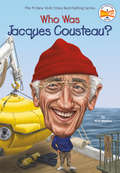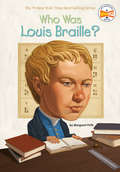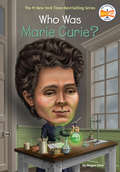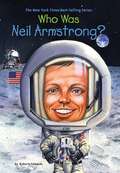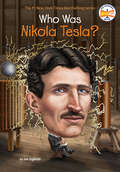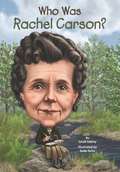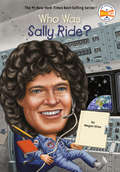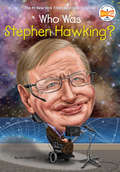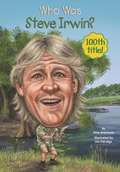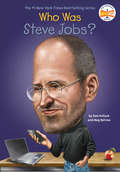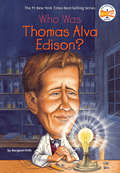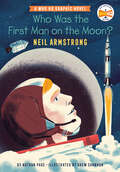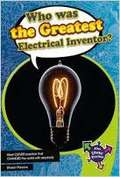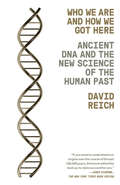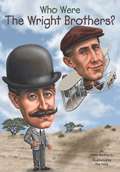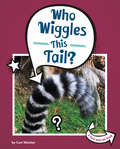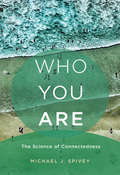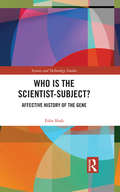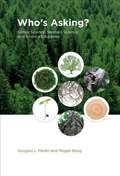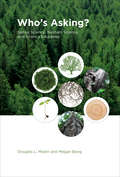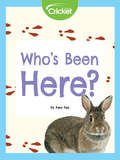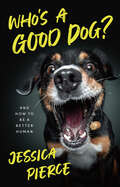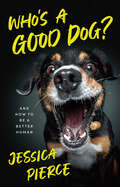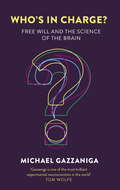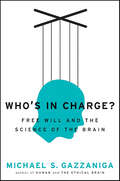- Table View
- List View
Who Was Jacques Cousteau? (Who was?)
by Nico Medina Nancy Harrison Dede PutraJacques Cousteau is the most famous and beloved name in the world of deep-sea exploration. Cousteau discovered his passion in 1938, when he first used a pair of goggles to dive off the coast of France. During his time as a French naval officer, he carried out many deep-sea experiments and improved upon early diving equipment. Soon, Cousteau began filming his underwater excursions and offering the world a glimpse below the surface. The documentary television series The Undersea World of Jacques Cousteau made the man, his work, and his red cap famous throughout the world.
Who Was Louis Braille?
by Margaret Frith Scott Anderson Robert SquierLouis Braille certainly wasn't your average teenager. Blind from the age of four, he was only fifteen when in 1824 he invented a reading system that converted printed words into columns of raised dots. Through touch, Braille opened the world of books to the sightless, and almost two hundred years later, no one has ever improved upon his simple, brilliant idea.
Who Was Marie Curie? (Who was?)
by Megan Stine Nancy Harrison Ted HammondBorn in Warsaw, Poland, on November 7, 1867, Marie Curie was forbidden to attend the male-only University of Warsaw, so she enrolled at the Sorbonne in Paris to study physics and mathematics. There she met a professor named Pierre Curie, and the two soon married, forming one of the most famous scientific partnerships in history. Together they discovered two elements and won a Nobel Prize in 1903. (Later Marie won another Nobel award for chemistry in 1911.) She died in Savoy, France, on July 4, 1934, a victim of many years of exposure to toxic radiation.
Who Was Neil Armstrong? (Who was?)
by Roberta Edwards Nancy Harrison Stephen MarchesiAvailable in time to commemorate the 40th anniversary of the Apollo 11 mission, this biography introduces youngsters to Neil Armstrong, the first man to step foot on the Moon. Illustrations.
Who Was Nikola Tesla? (Who Was?)
by John Hinderliter Jim Gigliotti Who HqGet ready for the electrifying biography of Nikola Tesla--part creative genius, part mad scientist, and 100% innovator. <P><P>When Nikola Tesla arrived in the United States in 1884, he didn't have much money, but he did have a letter of introduction to renowned inventor Thomas Edison. The working relationship between the two men was short lived, though, and the two scientist-inventors became harsh competitors. <P><P>One of the most influential scientists of all time, Nikola Tesla is celebrated for his experiments in electricity, X-rays, remote controls, and wireless communications. His invention of the Tesla coil was instrumental in the development of radio technology.
Who Was Rachel Carson? (Who was?)
by Nancy Harrison Sarah Fabiny Dede PutraThough she grew up in rural Pennsylvania, Rachel Carson dreamed of the sea. In 1936 she began work with the Bureau of Fisheries and soon after published Under the Sea Wind, her first of many nature books. Her 1962 bestseller, Silent Spring, sent shockwaves through the country and warned of the dangers of DDT and other pesticides. A pioneering environmentalist, Rachel Carson helped awaken the global consciousness for conservation and preservation.
Who Was Sally Ride? (Who was?)
by Megan StineIn 1978, Sally Ride, a PhD candidate at Standford University, responded to a newspaper ad to join the US astronaut program. She was accepted and became the first American woman astronaut to fly in space! Among her other accomplishments, she played tennis like a professional, was an astrophysicist who helped develop a robotic arm for space shuttles, and later, through Sally Ride Science, worked to make science cool and accessible for girls. Sally Ride, who died on July 23, 2012, will continue to inspire young children.
Who Was Stephen Hawking? (Who Was?)
by Who HQ Jim E. GigliottiLearn more about the renowned British scientist, professor, and author who spent his entire career trying to answer the question: "Where did the universe come from?"Stephen Hawking was born exactly three hundred years after the death of the scientist Galileo, so maybe it was written in the stars that he would become a famous scientist in his own right. Although he was diagnosed with a neurological disease at age 21, Stephen did not let the illness define his life. Known for his groundbreaking work in physics, and identified by his wheelchair and computerized voice system, Stephen continued his research until his death in 2018. He is best known for his black hole theories and his best-selling book A Brief History of Time. Stephen Hawking is an example of a person who had a great mind, but an even greater spirit.
Who Was Steve Irwin? (Who was?)
by Dina Anastasio Jim EldridgeBy popular demand, the 100th Who Was...? subject is Steve Irwin!Steve Irwin did not have a typical childhood. Born in Melbourne, Australia, on February 22, 1962, he was raised on the wildlife park his parents owned. He cared for the animals and especially loved reptiles--he got a python for his sixth birthday! At nine years old, Steve was already helping his father wrestle small crocodiles. He became a crocodile trapper after graduating high school, catching the creatures before dangerous poachers could. Steve met his wife, Terri, at his family's park, and instead of a honeymoon, the pair filmed a wildlife documentary that led to the creation of the well-known series The Crocodile Hunter. Tragically, Steve was killed on September 4, 2006 while filming a documentary when a stingray attacked, piercing his heart. He was forty-four years old. However, his life's work obviously still strikes a chord with kids who voted him the winner of the 100th Who Was...? title.
Who Was Steve Jobs? (Who was?)
by Pam Pollack Meg BelvisoSteve Jobs, adopted in infancy by a family in San Francisco, packed a lot of life into fifty-six short years. In this Who Was#133;? biography, children will learn how his obsession with computers and technology at an early age led him to co-found and run Apple, in addition to turning Pixar into a ground-breaking animation studio. A college dropout, Jobs took unconventional steps in his path to success and inspired the best and the brightest to come with him and #147;change the world. ”
Who Was Thomas Alva Edison? (Who was?)
by Margaret Frith John O'Brien Nancy HarrisonOne day in 1882, Thomas Edison flipped a switch that lit up lower Manhattan with incandescent light and changed the way people live ever after. The electric light bulb was only one of thousands of Edison's inventions, which include the phonograph and the kinetoscope, an early precursor to the movie camera. As a boy, observing a robin catch a worm and then take flight, he fed a playmate a mixture of worms and water to see if she could fly! Here's an accessible, appealing biography with 100 black-and-white illustrations.
Who Was the First Man on the Moon?: A Who HQ Graphic Novel (Who HQ Graphic Novels)
by Who HQ Nathan PageDiscover the story behind Neil Armstrong and the Apollo 11 mission in this immersive graphic novel -- by Montague Twins creative duo Nathan Page and Drew Shannon.Presenting Who HQ Graphic Novels: an exciting new addition to the #1 New York Times Best-Selling Who Was? series! From his childhood experiments to his first encounters with flight, explore the steps Neil Armstrong took in order to become the first person to land on the moon. A story of calculated risk, perseverance, and earth-defying reward, this graphic novel invites readers to immerse themselves in the life of the famous astronaut -- brought to life by gripping narrative and vivid full-color illustrations that fly off the page.
Who Was the Greatest Electrical Inventor? (Into Reading, Level S #9)
by Sharon ParsonsNIMAC-sourced textbook <p><p> Life without electricity is difficult to imagine. Almost everything we do—and every gadget or appliance we have in our homes—relies on electricity. In this book, we'll meet some of the clever inventors and scientists whose 'electric' contributions have made such a difference in our lives. Who was the greatest electrical inventor? You decide!
Who We Are and How We Got Here: Ancient DNA and the New Science of the Human Past
by David ReichHere is a groundbreaking book about how the extraction of ancient DNA from ancient bones has profoundly changed our understanding of human prehistory while resolving many long-standing controversies. Massive technological innovations now allow scientists to extract and analyze ancient DNA as never before, and it has become clear—in part from David Reich's own contributions to the field—that genomics is as important a means of understanding the human past as archeology, linguistics, and the written word. In Who We Are and How We Got Here, Reich describes with unprecedented clarity just how the human genome provides not only all the information that a fertilized human egg needs to develop but also contains within it the history of our species. He explains how the genomic revolution and ancient DNA are transforming our understanding of the lineage of modern humans and how DNA studies reveal the deep history of inequality—among different populations, between the sexes, and among individuals within a population. His book gives the lie to the orthodoxy that there are no meaningful biological differenced among human populations, and at the same time uses the definitive evidence provided by genomics to show that the differences that do exist are unlikely to conform to familiar stereotypes.
Who Were the Wright Brothers? (Who Was?)
by Nancy Harrison James Buckley Tim FoleyAs young boys, Orville and Wilbur Wright loved all things mechanical. As young men, they gained invaluable skills essential for their success by working with printing presses, bicycles, motors, and any sort of machinery they could get their hands on. As adults, the brothers worked together to invent, build, and fly the world's first successful airplane. This is the fascinating story of the two inventors and aviation pioneers who never lost sight of their dream: to fly, and to soar higher!
Who Wiggles This Tail? (Whose Is This?)
by Cari MeisterSwish! This photo-guessing game challenges pre-readers to guess whose tail appears in each image. The scaly, tufted, and bushy answers may be surprising!
Who You Are: The Science of Connectedness (The\mit Press Ser.)
by Michael J. SpiveyWhy you are more than just a brain, more than just a brain-and-body, and more than all your assumptions about who you are.Who are you? Are you just a brain? A brain and a body? All the things you have done and the friends you have made? Many of us assume that who we really are is something deep inside us, an inner sanctuary that contains our true selves. In Who You Are, Michael Spivey argues that the opposite is true: that you are more than a brain, more than a brain-and-body, and more than all your assumptions about who you are. Rather than peeling layers away to reveal the inner you, Spivey traces who you are outward. You may already feel in your heart that something outside your body is actually part of you—a child, a place, a favorite book. Spivey confirms this intuition with scientific findings.With each chapter, Spivey incrementally expands a common definition of the self. After (gently) helping you to discard your assumptions about who you are, he draws on research in cognitive science and neuroscience to explain the back-and-forth among all the regions of the brain and the interaction between the brain and body. He then makes the case for understanding objects and locations in your environment as additional parts of who we are. Going even further, he shows that, just as interaction links brain, body, and environment, ever-expanding systems of interaction link humans to other humans, to nonhuman animals, and to nonliving matter. This may seem an interaction or two too far. But you don't have to take his word for it—just consider the evidence he presents.
Who is the Scientist-Subject?: Affective History of the Gene (Science and Technology Studies)
by Esha ShahThis book explores two disparate sets of debates in the history and philosophy of the life sciences: the history of subjectivity in shaping objective science and the history of dominance of reductionism in molecular biology. It questions the dominant conception of the scientist-subject as a neo-Kantian ideal self – that is, the scientist as a unified and wilful, self-determined, self-regulated, active and autonomous, rational subject wilfully driven by social and scientific ethos – in favour of a narrative that shows how the microcosm of reductionism is sustained, adopted, questioned, or challenged in the creative struggles of the scientist-subject. The author covers a century-long history of the concept of the gene as a series of "pioneering moments" through an engagement with life-writings of eminent scientists to show how their ways of being and belonging relate with the making of the science. The scientist-self is theorized as fundamentally a feeling, experiencing, and suffering subject split between the conscious and unconscious and constitutive of personality aspects that are emotional/psychological, "situated" (cultural and ideological), metaphysical, intersubjective, and existential at the same time. An engaging interdisciplinary interpretation of the dominance of reductionism in genetic science, this book will be of major interest to scholars and researchers of science, history, and philosophy alike.
Who's Asking?
by Douglas L. Medin Megan BangThe answers to scientific questions depend on who's asking, because the questions asked and the answers sought reflect the cultural values and orientations of the questioner. These values and orientations are most often those of Western science. In Who's Asking?, Douglas Medin and Megan Bang argue that despite the widely held view that science is objective, value-neutral, and acultural, scientists do not shed their cultures at the laboratory or classroom door; their practices reflect their values, belief systems, and worldviews. Medin and Bang argue further that scientist diversity -- the participation of researchers and educators with different cultural orientations -- provides new perspectives and leads to more effective science and better science education. Medin and Bang compare Native American and European American orientations toward the natural world and apply these findings to science education. The European American model, they find, sees humans as separated from nature; the Native American model sees humans as part of a natural ecosystem. Medin and Bang then report on the development of ecologically oriented and community-based science education programs on the Menominee reservation in Wisconsin and at the American Indian Center of Chicago. Medin and Bang's novel argument for scientist diversity also has important implications for questions of minority underrepresentation in science.
Who's Asking?: Native Science, Western Science, and Science Education (The\mit Press Ser.)
by Douglas L. Medin Megan BangAnalysis and case studies show that including different orientations toward the natural world makes for more effective scientific practice and science education.The answers to scientific questions depend on who's asking, because the questions asked and the answers sought reflect the cultural values and orientations of the questioner. These values and orientations are most often those of Western science. In Who's Asking?, Douglas Medin and Megan Bang argue that despite the widely held view that science is objective, value-neutral, and acultural, scientists do not shed their cultures at the laboratory or classroom door; their practices reflect their values, belief systems, and worldviews. Medin and Bang argue further that scientist diversity—the participation of researchers and educators with different cultural orientations—provides new perspectives and leads to more effective science and better science education.Medin and Bang compare Native American and European American orientations toward the natural world and apply these findings to science education. The European American model, they find, sees humans as separated from nature; the Native American model sees humans as part of a natural ecosystem. Medin and Bang then report on the development of ecologically oriented and community-based science education programs on the Menominee reservation in Wisconsin and at the American Indian Center of Chicago. Medin and Bang's novel argument for scientist diversity also has important implications for questions of minority underrepresentation in science.
Who's Been Here?
by Amy TaoHave you ever wondered why there are different shaped footprints in the mud or snow? An animal may be nearby! Discover the many animals that are in your environment! Every animal creates different tracks. Some tracks are large, and some tracks are small. Some animals may have five toes while others may have only a few. How many animal tracks can you name?
Who's a Good Dog?: And How to Be a Better Human
by Jessica PierceA guide to cultivating a shared life of joy and respect with our dogs. Who’s a Good Dog? is an invitation to nurture more thoughtful and balanced relationships with our canine companions. By deepening our curiosity about what our dogs are experiencing, and by working together with them in a spirit of collaboration, we can become more effective and compassionate caregivers. With sympathy for the challenges met by both dogs and their humans, bioethicist Jessica Pierce explores common practices of caring for dogs, including how we provide exercise, what we feed, how and why we socialize and train, and how we employ tools such as collars and leashes. She helps us both to identify potential sources of fear and anxiety in our dogs’ lives and to expand practices that provide physical and emotional nourishment. Who’s a Good Dog? also encourages us to think more critically about what we expect of our dogs and how these expectations can set everyone up for success or failure. Pierce offers resources to help us cultivate attentiveness and kindness, inspiring us to practice the art of noticing, of astonishment, of looking with fresh eyes at these beings we think we know so well. And more than this, she makes her findings relatable by examining facets of her relationship with Bella, the dog in her life. As Bella shows throughout, all dogs are good dogs, and we, as humans and dog guardians, could be doing a little bit better to get along with them and give them what they need.
Who's a Good Dog?: And How to Be a Better Human
by Jessica PierceA New Scientist Best Book of 2023A guide to cultivating a shared life of joy and respect with our dogs. Who’s a Good Dog? is an invitation to nurture more thoughtful and balanced relationships with our canine companions. By deepening our curiosity about what our dogs are experiencing, and by working together with them in a spirit of collaboration, we can become more effective and compassionate caregivers. With sympathy for the challenges met by both dogs and their humans, bioethicist Jessica Pierce explores common practices of caring for dogs, including how we provide exercise, what we feed, how and why we socialize and train, and how we employ tools such as collars and leashes. She helps us both to identify potential sources of fear and anxiety in our dogs’ lives and to expand practices that provide physical and emotional nourishment. Who’s a Good Dog? also encourages us to think more critically about what we expect of our dogs and how these expectations can set everyone up for success or failure. Pierce offers resources to help us cultivate attentiveness and kindness, inspiring us to practice the art of noticing, of astonishment, of looking with fresh eyes at these beings we think we know so well. And more than this, she makes her findings relatable by examining facets of her relationship with Bella, the dog in her life. As Bella shows throughout, all dogs are good dogs, and we, as humans and dog guardians, could be doing a little bit better to get along with them and give them what they need.
Who's in Charge?: Free Will and the Science of the Brain
by Michael GazzanigaThe prevailing orthodoxy in brain science is that since physical laws govern our physical brains, physical laws therefore govern our behaviour and even our conscious selves. Free will is meaningless, goes the mantra; we live in a 'determined' world.Not so, argues the renowned neuroscientist Michael S. Gazzaniga as he explains how the mind, 'constrains' the brain just as cars are constrained by the traffic they create. Writing with what Steven Pinker has called 'his trademark wit and lack of pretension,' Gazzaniga ranges across neuroscience, psychology and ethics to show how incorrect it is to blame our brains for our behaviour. Even given the latest insights into the physical mechanisms of the mind, he explains, we are responsible agents who should be held accountable for our actions, because responsibility is found in how people interact, not in brains.An extraordinary book, combining a light touch with profound implications, Who's in Charge? is a lasting contribution from one of the leading thinkers of our time.
Who's in Charge?: Free Will and the Science of the Brain
by Michael S. Gazzaniga“Big questions are Gazzaniga’s stock in trade.”—New York Times“Gazzaniga is one of the most brilliant experimental neuroscientists in the world.”—Tom Wolfe“Gazzaniga stands as a giant among neuroscientists, for both the quality of his research and his ability to communicate it to a general public with infectious enthusiasm.”—Robert Bazell, Chief Science Correspondent, NBC News The author of Human, Michael S. Gazzaniga has been called the “father of cognitive neuroscience.” In his remarkable book, Who’s in Charge?, he makes a powerful and provocative argument that counters the common wisdom that our lives are wholly determined by physical processes we cannot control. His well-reasoned case against the idea that we live in a “determined” world is fascinating and liberating, solidifying his place among the likes of Oliver Sacks, Antonio Damasio, V.S. Ramachandran, and other bestselling science authors exploring the mysteries of the human brain.
